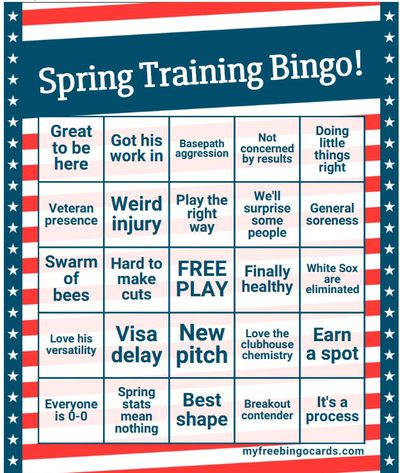
Which of the non-roster invitees are most likely to make an impact on the season?
Introduction
The beginning of baseball season, much like spring itself, starts with the subtlest of signs: the lengthening of the daylight, the first crocuses popping out of the ground, or buds of leaves beginning to be appear on trees. For baseball fans, there are few things as uplifting (other than Opening Day of course) than hearing “pitchers and catchers reporting.” Even if it is mostly symbolic at this point, it truly is the first signal that the long offseason with no baseball is winding down and the hope of a new season is approaching. It also brings with it the inevitable trite expressions of players’ conditioning (best shape of his life) as ballplayers and commenters look to fill airtime – see the bingo card below. Between those hokey sayings and on-field interviews, there will be some honest-to-goodness roster competitions that will include those players are already on the 40-man roster as well as those off it – non-roster invitees (NRIs).
As a reminder, major league clubs have two separate rosters: a 26-man roster (or “active roster”) and a 40-man roster that includes everyone from the first roster as well as any players on the 7-, 10-, or 15-day ILs. Generally speaking, Spring Training is the only period during which a team can exceed those limits to maximize high-level prospects’ exposure to higher-caliber competition and to allow teams the most flexibility with their roster construction. Last year, the D-Backs included 26 NRIs on their Spring Training roster and six of those (Humberto Castellanos, Logan Allen, Brandon Hughes, Tucker Barnhart, Kevin Newman, and Adrian Del Castillo) appeared with the big league club at one point in the season – most notably the final two. This go-around, the team is only carrying 19 such players going into Spring Training including ninth-ranked D-Backs’ prospect Gino Groover So, as part of an ongoing series focusing on NRIs, I wanted to take a look at which of these heralded prospects or veterans looking for a comeback have the best chance of making a meaningful impact on the team at some point in the season.

Thyago Vieira
If the name sounds familiar, it’s because Vieria (pronounced Vee-air-uh) was a savvy waiver pickup from the Baltimore Orioles last year, tossing 15.2 IP with a 2.87 ERA and 1.277 WHIP. However, there were some warning signs that the performance wasn’t sustainable, including a 4.76 FIP and a Hard Hit Rate of 46.5 well above the MLB average of 38.9. Evidently those peripherals were enough to scare off Hazen as the 32-year old veteran was outrighted to Reno at the end of July when the D-Backs made a series of moves to bolster their bullpen. Still, as we see every year, teams can never have too much relief pitching and a veteran with excellent extension and a fastball that nearly touches triple digits will always have a chance to contribute to a team somehow. The biggest challenge for the Brazilian native will be finding a place for him on a crowded pitching staff with a plethora of rotation options and enviable depth in the bullpen.
Kyle Backhus
Contrastingly to Vieria, Backhus has yet to make his MLB debut, but it could be coming sometime this season as the undrafted Texan has steadily made his way through the minor leagues since signing a minor league deal with the D-Backs way back in the summer of 2021. This is also his second consecutive invite to Spring Training with the club and, as above, relief pitching is critical and teams are always looking for additional depth. Despite being a starter while attending Sam Houston State, Backhus made a transition to the bullpen after his first professional season and has never looked back. Since that point, the 27-year old has consistently posted sub-4 ERAs across all levels despite the elevated offensive environments inherent to those leagues. Regardless of the uphill battle he faces in battling for a roster spot on the crowded pitching staff, I am always a sucker for a professional underdog who was counted out by everyone but themselves.
Tristin English
Finally, we have a former highly-touted prospect whose stock has slowly faded since being taken as a third-rounder back in 2019 – once cracking the top-30 for the club in the 2020 and 2021 versions. Originally a two-player while playing for the Georgia Institute of Technology, he has spent time at both infield and outfield corners where his arm strength is a real difference-maker. Unfortunately, his bat has not quite kept up with that arm strength as he has failed to break through since his drafting with a sold but not spectacular .276/.349/.462 slash line out in Reno despite the hitter-friendly climes. Still, a player with the kind of positional flexibility that English has is a valuable commodity since both corner infield positions lack clear successors after 2025. In my opinion, he has little left to learn in Reno with nearly 200 games under his belt and it’s high time to see if he has the capability of taking the next step.